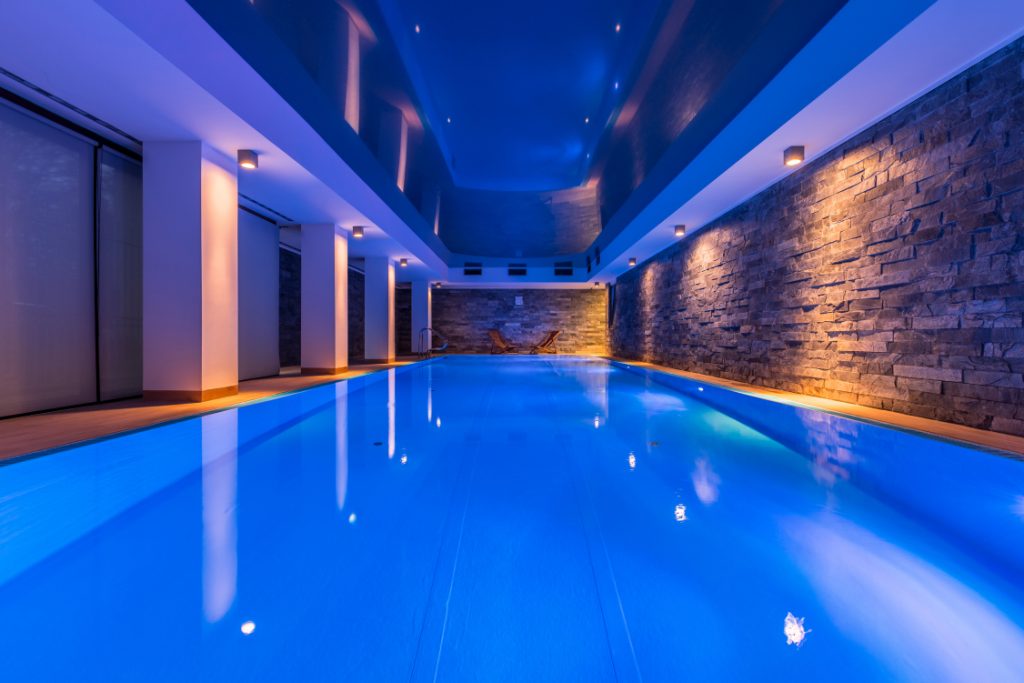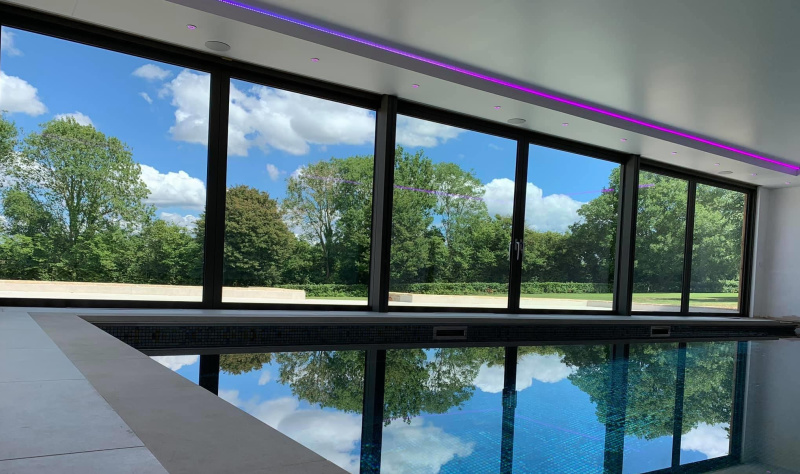Like most UK residents we are sure you are aware of the rapid increase in heating and energy costs in the UK over the last year or so. If you are also the owner of an indoor swimming pool we are sure these costs are on your mind more than most. So what steps can you take to minimise the impact? Read our comprehensive guide below.

Water heating
- How do you use your indoor pool? If it is for exercise as opposed to relaxation perhaps you can get away with lowering the temperature as you will soon heat up and there are also well cited health benefits to swimming in cold water. Or maybe your indoor pool is only used during certain times of day or the weekend. Adapt your heating of it accordingly. Recommended temperatures are 78-80 degrees for exercise and 82-84 degrees for recreational use. Use a pool thermometer to properly maintain your target temperature.
Saving water
- Water is expensive! There are number of ways you can minimise wastage:
- Add drainage channels around your pool perimeter to minimise water being splashed out of the pool and lost, instead returning it to the system.
- Minimise the need for backwashing (reversing the flow of water to flush out contaminants from a swimming pool filter) by changing from a sand or Diatomaceous Earth (D.E). filter to a cartridge filter or by adding a pre-filter to stop contaminants reaching the main filter.
- Use UV water treatment instead of chlorine as it uses less chemicals and therefore will need less backwashing.
Reduce need for filtration
- Check that your filtration system is used for the minimum amount of time necessary and isn’t on a timer that is set to cope with your pool’s highest bather load.
- You should also consider replacing older filtration systems with new, digital control units that are more accurate at maintaining filtration running times and pool temperature.
- Encourage users of your pool to shower first. This will introduce less contaminants into the pool and reduce the need for filtration.
Time your pumps
- Design, maintenance and awareness are all elements which can affect the efficiency of your pool heating system.
- You should attempt to decrease filtration time to the minimum required. It does not need to operate all day, wasting a lot of energy at the same time. Try 5 or 6 hours and if your water doesn’t seem clean try increasing the time incrementally until you are satisfied.
- It should be possible to use a timer to control your pump. Set your pump to run a number of brief cycles as opposed to running for a long period of time. Your pool will actually be cleaner using this method as the shorter, more frequent cycles allow debris to be filtered out of the pool faster because there is less build up. This also puts less pressure on the filter.
Change your pump
- Fit a new circulation pump to your pool and you could cut your energy bill significantly, ask your supplier to give you an estimate so you can check you will get your money back and more in savings. Generally you should be looking to see if a smaller, higher efficiency pump can do the job for you. You should be able to regulate the speed of your pump and turn it down apart from when you need to carry out a thorough clean.
Room heating
- To keep evaporation under control, air temperature in an indoor pool room should be approximately 2 degrees above the pool temperature. If your pool is being used frequently that is a fair amount of additional heating so you want to do everything you can to reduce heating costs. See other sections of this article for advice on that such as insulation, solar panels etc etc.
Maintenance
- It is important to properly maintain every aspect of your indoor swimming pool including the room itself in order to achieve optimal running costs.
Bifold doors
- Bifold doors are a popular option with pool houses as they let in lots of light and can connect your pool with your outdoor areas. We recommend you use bi-fold doors with the best U-Value, which indicates the insulation of a material.

Solar panels
- There are two types of solar panels you can use to save your indoor pool running costs. Solar Photovoltaic (PV) panels generate electricity you can use to power your pool equipment and heat pumps. Solar Thermal panels can be used to heat your water.
Heat pump
- As with solar panels there are a number of different heat pumps you can use to heat your pool.
- Air Source Heat Pumps can magnify the heat energy in our atmosphere up to a ratio of 6 units of energy output at a production cost of 1 unit.
- The other option is Ground Source Heat Pumps. The installation process is more complex and expensive, as you need a fair amount of land to lay the pipework underground. However once installed, they are more efficient than Air Source Heat pumps. The underground collectors absorb heat energy available throughout the year. This is maintained at a greater temperature than if it were above ground.
- You might also want to use a pool heat pump if you don’t already have one. A pool heat pump uses warmth drawn from the outside air to heat the pool water. Pool heat pumps cost more than gas heaters, but because of their high efficiencies, the yearly operating cost ends up being less than a gas heater. They can also last longer.
Ceiling
- As mentioned before the area surrounding your indoor pool is just as important as your pool and its operating systems if you want to conserve energy.
- We are in the business of stretch ceilings which are the perfect choice of ceiling for indoor swimming pools. They can help you save on heating costs as they are installed below your original ceiling so create another layer of insulation (and you can put additional insulation in this layer too!) between your room and your roof.
- They are very far longer-lasting and easier to maintain than other ceiling options, saving you more money in the long-run.
Lighting
- While we are talking about ceilings we should also mention lighting. LED long life lighting is the way to go as they use less energy and last longer. In combination with stretch ceilings you can also achieve some very impressive lighting effects like blue sky and white clouds or a twinkling night sky.

Roof and wall insulation
- As mentioned above with ceiling insulation, loft and wall insulation will help you reduce the costs of having to heat your room to maintain a good balance with your pool temperature.
Pool insulation
- We’re sure you have heard of wall and roof insulation, maybe not ceiling insulation, but did you know you can also insulate your swimming pool walls to retain the heat of your pool water. The insulation is installed underneath the concrete at the bottom of the pool and on the outside walls of the pool chamber.
Pool covers
- For heated swimming pools most of the heat is lost through surface water evaporation, so investing in a good quality swimming pool cover is a good idea. Their function is both heat and vapour retention, lost heat requires replacement and vapour escaping into the pool room environment will require additional dehumidification to protect the building.
- Maybe less so for inside pools but covers also prevent dirt and debris from getting into your pool water which will require more filtration energy and therefore cost to remove.
Use Saltwater
- Saltwater swimming pools offer a number of benefits. They require less maintenance and are less costly to sanitise your pool versus chlorine on an ongoing basis. Saltwater is also gentler on the skin, eyes and hair of and are particularly suitable for individuals with health conditions like asthma or allergies.
Build a smaller pool
- We apologise for stating the obvious but if you have not built your pool and are concerned about costs take the time to consider if you can reduce the size of your pool and consequently the cost to hear.
Rent out your pool
- Did you know apps like swimply now exist to help you rent out your swimming pools (or tennis court) by the hour?
We hope you found these ideas useful. If you would like to find out more about installing a stretch ceiling for your indoor pool please get in touch.
